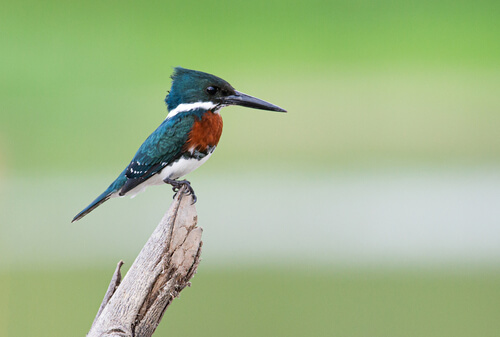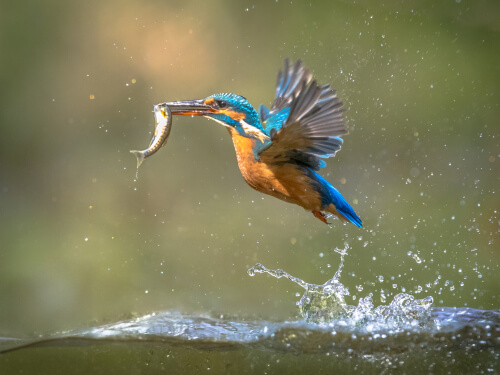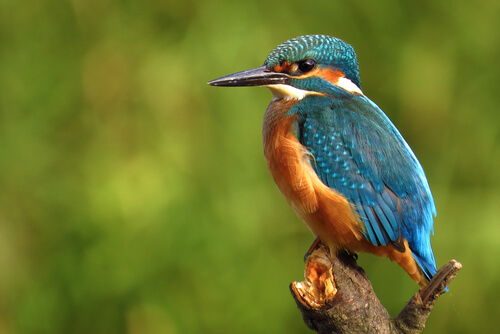
| Kingdom | Animalia |
| Phylum | Chordata |
| Class | Aves |
| Order | Coraciiformes |
| Family | Alcedinidae |
| Genus | Various |
| Niche | Predatory bird |
| Length | 3.9 – 18 in (10 -46 cm) |
| Weight | 0.32-18 lbs (9-500 g) |
| Lifespan | 15 years |
| Social Structure | Some species monogamous, others cooperative |
| Conservation Status | Some species common, others critically endangered |
| Preferred Habitat | Lakes, rivers, forested streams |
| Average Clutch Size | 2-10 eggs |
| Main Food Items and Prey | Fish, small mammals, amphibians, reptiles, and insects |
| Predators | Fox, wild and domestic cats, raccoons, snakes, humans |
The Basics
The Kingfisher is a family of medium-sized birds known for their fish-hunting feeding behavior. Kingfishers can be split into three categories or subfamilies. The largest group is the tree kingfishers (Halcyoninae), which include 12 genera including some kookaburra species. There are also river kingfishers (Alcedininae), including all American kingfishers, and the water kingfishers (Cerylinae), primarily of Africa, Southeast Asia, and Australia. Alcedininae is the most basal of these subfamilies, meaning that the other families evolved from it.
Appearance
In general, all kingfishers are medium-sized birds with long pointy bills that aid in capturing fish and other prey. The African dwarf kingfisher (Ispidina lecontei), at about 3.9 in (10 cm) long and 0.32-0.42 oz (9-12 g) in weight, is the smallest species. The giant kingfisher (Megacaeryle maxima), at about 9-15 oz (255-426 g) and 17-18 in (42-46 cm) is the largest species in Africa, while the laughing kookaburra (Dacelo novaeguineae), also known as the Australian kingfisher, is the heavier, with females weighing up to 18 oz (500 g).

Most species have bright plumage, often bright green, blue and orange hues such as those seen on the common European kingfisher. Most also have long, sharp bills. Many kingfishers have short legs with four toes on each foot, with three pointing forward. They have dark brown eyes that provide excellent vision, allowing them to spot their prey from a great distance before attacking. Since many species hunt for fish underwater, they have membranes that cover their eyes to protect them during impact with the water. The pied kingfisher (Ceryle rudis) goes beyond a simple membrane, featuring a boney-plate that slides across its eye as it hits the water instead.
Distribution and Habitat
With so many genera of kingfisher, they have a cosmopolitan – or wide-spread – distribution, existing in most temperate and tropical regions in the world in some form. However, there are relatively few species in the Americas, with most being rare or restricted to very small regions. Only the common kingfisher and belted kingfisher occur frequently.
Most kingfisher species are distributed throughout Africa, Southeast Asia, and Australia. Some individual species have large ranges, such as the common kingfisher, which occurs throughout Europe, North Africa, Asia, and the Solomon Islands. Others, however, are endemic to small areas, or even to a single island such as the Kofiau paradise kingfisher (Tanysiptera ellioti), which lives on an island near New Guinea.
Kingfishers occupy many habitats within their ranges. Despite their names and reputations as solely fish-eaters, less than half of all species live on rivers and lakes, with some species tolerating the driest deserts of Australia and others living high in the mountains. Many live in forests or small streams within the forests. Some species have been known to adapt well to human-developed areas such as agricultural zones and city parks. For other species, however, human development poses a significant threat to their habitat’s existence.
Prey and Predators
Many kingfishers do indeed eat fish. They are known for their speed and aggressive hunting tactics, in which they will dive into the water headfirst to ‘harpoon’ their prey with their sharp bills. However, depending on the species, they will also eat a variety of other prey such as shrimp-like crustaceans, frogs and lizards, insects, mollusks, and even snakes. Some species are generalists, eating various items, while others such as most water kingfishers (Cerylinae) are fishing specialists.

Kingfisher themselves are vulnerable to predation by various animals within their ranges. For example, foxes, wild cats, and other medium-to-large-sized animals within their ranges will hunt them, although it is difficult given their speed and dangerous bills. More commonly, these opportunistic animals will feed on their young and eggs if given the opportunity. Other animals such as the raccoon, which has been introduced in much of its range, and domestic cats are also threats to some kingfisher species.
Nesting and Reproduction
Many species of kingfisher are aggressively territorial. They tend to form monogamous breeding pairs, but some species such as the laughing kookaburra will practice a cooperative breeding strategy in which ‘helpers’ will assist the dominant breeding pair in raising their young.
All kingfishers will form nests, often in tree cavities or holes dug into the banks of a river, for example. Fascinatingly, some species will form their nests in termite nests. Most species will lay between 2-10 small white eggs per clutch. Males and females will both aid in nest-building and incubation duties. After hatching, young kingfishers typically remain with their parents for about 3-4 months and can live as long as 15 years.
Although some species have adapted well to human-developed areas, many species are threatened by this. Many species are forest-dwelling, and as deforestation continues to occur around the world, their habitats are steadily disappearing. Indeed, several species such as the Marquesan kingfisher (Todiramphus godeffroyi) is listed as critically endangered.
Fun Facts about Kingfisher!
Although relatively shy and elusive, the kingfisher has captured the imagination of humankind for centuries. With so many different species of kingfishers, there is no shortage of interesting fun facts about the species to explore such as how they maintain their beautiful plumage as well as insights into the less obvious feeding habits of some species.
How Do Kingfishers Get so Bright?
Many kingfisher species are known for their bright feathers. Some birds that share this trait use iridescence or pigments. However, most kingfishers’ plumage appears so bright due to the unique structural characteristics of their feathers that cause blue light to scatter.
As with most rules, however, there is an exception. The kingfishers native to the Americas, such as the American green kingfishers (Chloroceryle spp.), do indeed use iridescence or semi-iridescence to produce their brilliant shine. Peacock feathers also gain their luster in this way.
The Physicist Bird
Many kingfisher species hunt their prey underwater, diving at rapid speeds to catch small fish swimming just below the surface. Kingfishers are highly adept at this behavior, suggest they are capable of compensating for the refraction of light in water, which can skew the perceived location away from the actual location of something observed underwater. They are also able to judge the depth at which a prey item is swimming, all of which is important in trying to catch their prey using stealth and surprise.

More Than a Fisher
Perhaps surprisingly, not all species of kingfisher subside on a diet of fish. Although famous for their long, dagger-like bills that they use to capture fish, many species’ bills are shorter and broader, allowing them to capture prey from the ground such as insects and small mammals. Perhaps the least typical bill is that of the shovel-billed kookaburra (Clytoceyx rex), which has a special shape that allows it to dig through dirt and debris of the forest floor instead of dive for fish.
